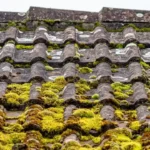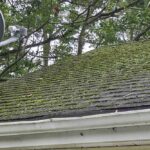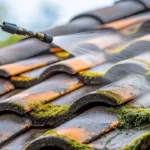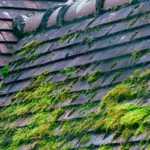Roof maintenance is crucial for ensuring the longevity of your home. One common issue homeowners face is the growth of moss on their roofs. This roof moss do it yourself guide will equip you with the knowledge needed to tackle this issue head-on. By following these tips, you can protect your roof and enhance your home’s overall appearance.

Understanding Roof Moss
Moss is a type of plant that thrives in damp, shaded environments. It can grow on various surfaces, including roofs. While it might seem harmless, moss can cause significant damage over time. It holds moisture against the roof surface, leading to rot and decay. Additionally, moss can cause shingles to lift, which might result in leaks.
Why Remove Moss from Your Roof?
Removing moss is vital for maintaining the integrity of your roof. Moss can shorten the lifespan of roofing materials and lead to costly repairs. Moreover, a moss-covered roof can negatively impact your home’s curb appeal. By removing moss, you protect your investment and keep your home looking its best.
When is the Best Time for Moss Removal?
The ideal time to remove moss is during the late spring or early fall. During these seasons, the weather is mild and dry, allowing for safe and effective moss removal. Avoid removing moss during wet or icy conditions, as this can be dangerous.
Gathering the Right Tools and Materials
Before you begin, ensure you have the necessary tools and materials. You’ll need a sturdy ladder, soft-bristle brush, moss removal solution, and protective gear such as gloves, goggles, and a mask. Having these items on hand will make the process smoother and safer.
Choosing a Moss Removal Solution
There are several options for moss removal solutions. You can purchase a commercial product or create a homemade solution using water and bleach. If you prefer a natural approach, vinegar or baking soda mixed with water can also be effective. Regardless of your choice, ensure you follow the manufacturer’s instructions or recommended ratios for homemade solutions.
Steps for DIY Roof Moss Removal
Step 1: Ensure Safety First
Safety is paramount when working on a roof. Always use a sturdy ladder and have someone assist you if possible. Wear non-slip shoes and protective gear to prevent injuries.
Step 2: Apply the Moss Removal Solution
Spray the moss removal solution onto the affected areas of the roof. Allow the solution to sit for the recommended time to effectively kill the moss. This usually takes about 20-30 minutes, but refer to the product instructions for specific guidance.
Step 3: Gently Remove the Moss
Using a soft-bristle brush, gently scrub the moss off the roof. Be careful not to damage the shingles during this process. Work in small sections and take your time to ensure thorough removal.
Step 4: Rinse the Roof
After removing the moss, rinse the roof with clean water to remove any remaining solution and debris. This step is crucial for preventing any potential damage from leftover chemicals.
Preventing Future Moss Growth
Once you’ve successfully removed the moss, take steps to prevent its return. Trim overhanging branches to allow more sunlight on the roof. Ensure gutters are clean and functioning properly to prevent moisture buildup. Consider adding zinc or copper strips to the roof ridge, as these metals are known to inhibit moss growth.
When to Call a Professional
While this roof moss do it yourself guide provides comprehensive steps for removal, there are instances where professional help might be necessary. If your roof is excessively steep or the moss growth is severe, hiring a professional can ensure safe and effective removal.
Conclusion
Maintaining a moss-free roof is essential for the health and appearance of your home. By following this roof moss do it yourself guide, you can keep your roof in excellent condition and avoid costly repairs. Remember, regular maintenance and prevention are key to long-term roof care.

FAQ
How often should I check for moss on my roof?
It’s recommended to inspect your roof for moss growth at least twice a year, ideally in the spring and fall.
Can I use a pressure washer to remove moss?
While a pressure washer can remove moss, it can also damage shingles if not used carefully. It’s best to use a soft-bristle brush for gentle removal.
What are the best moss prevention methods?
Regular roof inspections, trimming overhanging branches, and installing zinc or copper strips are effective methods for preventing moss growth.
For more tips on roof moss maintenance, visit Roofing Megastore and check out this guide on Roof Moss in Coastal Climates.
This article contains affiliate links. We may earn a commission at no extra cost to you.








